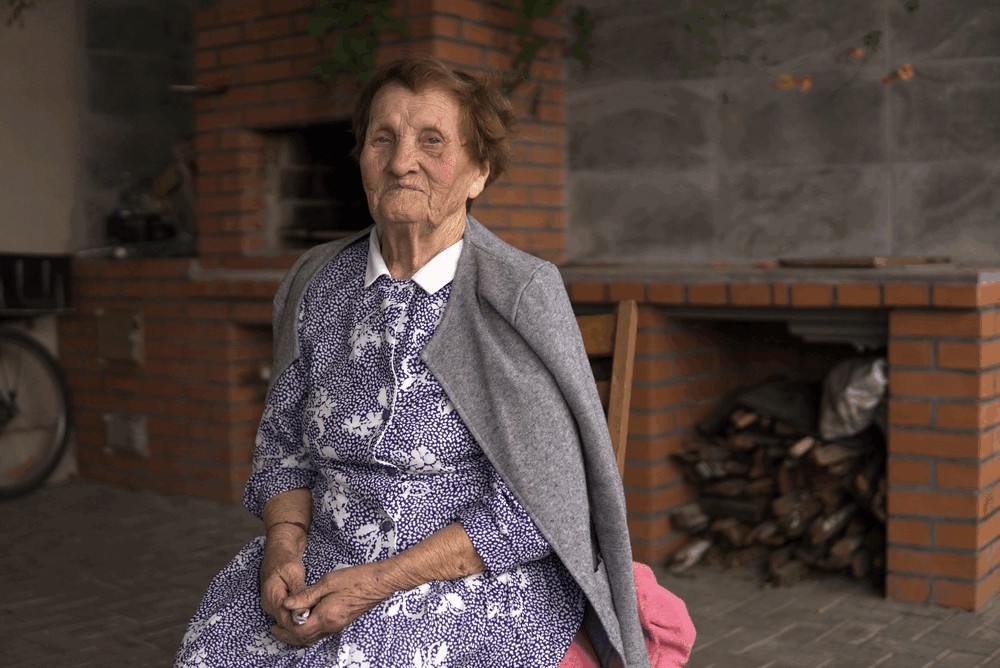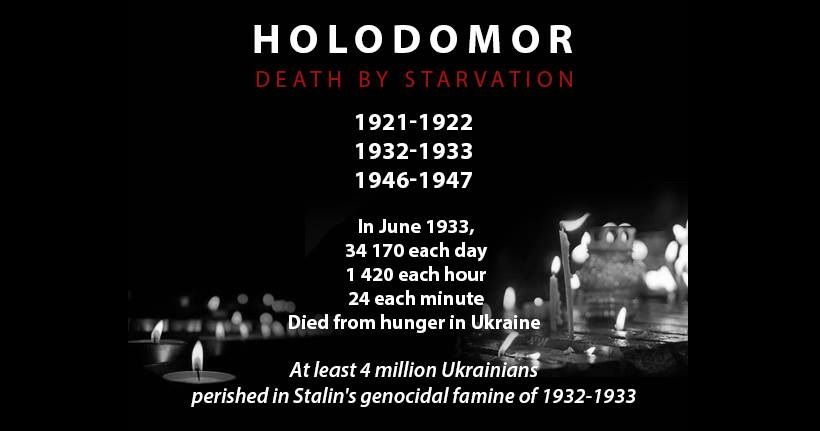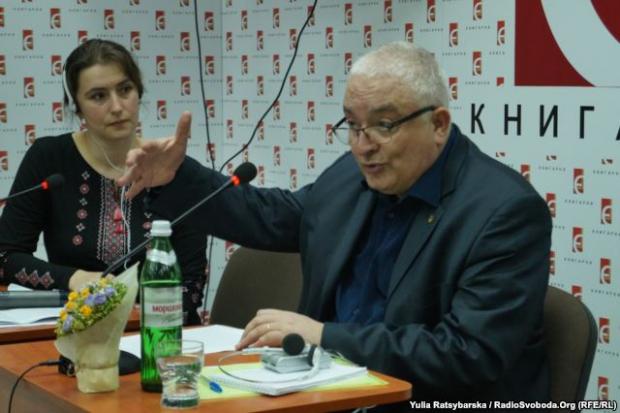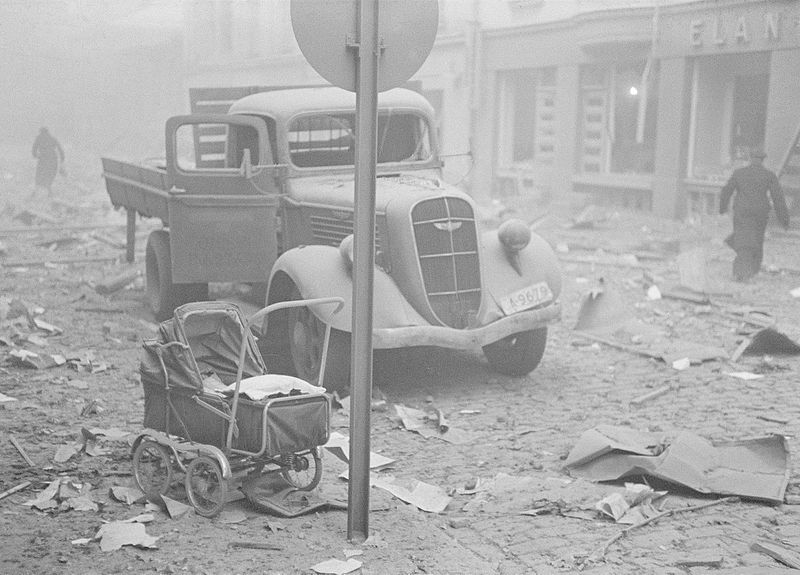Oleksandra Leontieva, 96, was an eight-year-old peasant half-orphan in 1932-1933, when her south-Ukrainian village was hit by the Holodomor, the genocidal famine of Ukrainians by the Soviet authorities which killed millions. She recollects how her family survived by resorting to eating river tortoises, gophers, various unedible plants, and how her mother used to dig out grain stored by field mice in their holes. This story is one of many eyewitness accounts gathered in the expeditions of the Kyiv-based Holodomor Museum.
Traveling throughout Ukraine and recording the 1932-1933 Holodomor genocide witnesses, the Holodomor Museum’s employees listened to the hundreds of accounts of the people who survived the horrible pages of Ukrainian history. All witnesses told about the nightmares of dekulakization, Soviet “grain procurements,” and the man-made Holodomor famine, about their ways of survival and mass deaths. Their stories are chilling, each account is unique and worth recording and remembering.
On this expedition, the museum team visited the Black Sea coastal city of Mykolaiv, where the historians recorded the story of 96-year-old Oleksandra Leontieva, who had survived the Holodomor in her native village of Lukianivka (then Lenino), Bashtanka Raion, Mykolaiv Oblast.
Oleksandra lost her father before the Holodomor, her mother desperately gave up one of her children to a foster family due to poverty
Head of the Leontiev family, Oleksandra’s father Pylyp died in 1929 of some lung disease, leaving his partner Motrona a single mother with their four children. The family was poor, they had only one cow, and the mother decided to join the newly-established kolkhoz willingly. However, she earned neither food nor money there.
Kolkhoz members worked for the so-called trudodens compensated in kind instead of money – and the Leontievs received next to none compensation. The collective farm membership was de-facto slavery, established by the communist totalitarian regime.
“My mother told me my father was willing to join the collective farm, and if he hadn’t fallen ill, he’d have joined it,” Oleksandra says. “Because there they were promised, ‘Come to us, everything would be yours, the land would belong to the people.’ And all the people gathered and joined the kolkhoz. We didn’t resist. And my mom went there just after the head of the village council established the collective farm. It was Kolkhoz named after [Ukrainian poet] Taras Shevchenko in the village of Lenino, you see. But afterwards. she was recalling all the time her poverty and the misery that she suffered while bringing us up. She used to go to the steppe where mice had their holes in which they stored grain. My mom went there at night, if she’d find the hole, she’d take away the mouse’s grain, and it would be our food. She went there at night in order to find at least something, you see?”
- Read also: My neighbors escaped starvation by eating grain stored by field mice | Voices of Holodomor witnesses
Indeed, the rations received for the collective farm’s trudodens were miserable, but even worse was that the kolkhoz managers never considered the existence of their workers’ family members. Thus, the single mother with her four children had to survive on one person’s scarce ration.

Unable to withstand the pressure of the circumstances created by the communist totalitarian regime, the mother took a desperate step—she gave one of her daughters to a family of her acquaintances. As it later turned out, the girl left her original family for good.
“There were many children, but the mother was only one. So she gave one of her daughters to a childless woman from the neighboring village. Three of us remained. This woman sometimes came to us with our sister to visit us,” Oleksandra says.
According to Oleksandra Leontieva, she is still in touch with her sister. They grew up in different families but preserved their bonds as sisters.
“People in leather jackets” confiscated all food from villagers
Dekulakization of 1928-1929 bypassed the Leontiev family as they didn’t have a large farm. They had one cow but even so, they didn’t have enough food for their animal. Oleksandra Leontieva recalls that their cow was so skinny and didn’t give any milk. Nevertheless, the family would keep it until 1933.
“What did the word ‘kulak’ mean? That he was wealthy. That he had more cattle. ‘Kulaks’ were rich,” Oleksandra says.
Soviet propaganda worked tirelessly to label wealthy, hard-working Ukrainian farmers as “kulaks.”
The searches at the beginning of the Holodomor genocide touched every family, every household.
“Strangers were walking around the village,” Oleksandra Leontieva says. “They wore such jackets, as I remember, such leather jackets. They were going around the village and took everything that people had. The locals didn’t know them. Local people, women said, ‘What do they want from us? Oh, to take everything to the last crumb!’ And we have nothing…’ That’s what I heard from them.”
Although the activists – these “people in jackets” – wielded only iron sticks, the inhabitants of Lenino, as Oleksandra remembers, didn’t resist much. The indignant locals did nothing more than gather in the streets to complain, “What’s this? We are being robbed. They bleed us white. We’ve got nothing. Why do they loiter around? Who are these people?”
During those searches, the communist activists took nothing from the Leontiev family as there was nothing to take at all, according to Oleksandra. But the very scene of searching her family’s house was deeply traumatic to eight-year-old Oleksandra and engraved into her memory,
“Two men entered our house, they wore jackets of some kind, as I remembered. And I noticed their iron stick, like a ramrod, and they started poking it all round the house where they thought it necessary. They poked and searched hoping to find some grain or flour. But we didn’t have it. Didn’t have. Later they were coming not only to us. They visited other people too, all round the village. Once at someone’s place they found kidney beans and took them away, you know. They did search even inside the ovens. Everywhere, in order to find something. And we say, ‘We have nothing. We don’t have any grain.’ And my mom said them the same,” Ms. Leontieva said.

The locals were supportive and helped each other. As the witness recalls, the villagers were friendly and didn’t even think of snitching on neighbors or other fellow villagers, which sometimes happened in other villages according to other eyewitnesses. Under the Soviet “Five Ears of Grain Law,” all agricultural lands of Ukrainians were owned by collective farms while taking anything from the fields – even after the crops were reaped – was a punishable crime. However, in Oleksandra’s village, even the armed patrols that guarded the kolkhoz fields sometimes closed their eyes to children and adults who were taking to stubble fields to look for any leftover grains. The guards saw people starve and didn’t drive them away.
As everything edible was taken away from all village houses dooming people to hungry deaths, the “people in leather jackets” left the village.
“Where they disappeared, we don’t know. Those who walked with the ramrods. Where did these people go? Probably, they set off to the raion center. People believed that those came from the city or from the raion center,” Oleksandra says.
They left but destruction, fear, and hunger brought by the strangers was there to stay.
“Of course, I was afraid. I was afraid of these people,” Oleskandra Leontieva says. “I feared he would skewer me me with that ramrod. I was afraid. But I was trying to take a look at them. I wanted to know what they were and what kind of people they were. Those weren’t from our village. They were strangers. I got down from the stove bench, looked at them and thought, why were they poking? there is nothing there! and they… And they stared into the oven, even into the oven.”
The family had to eat tortoises, gophers, unedible plants to survive during the Holodomor
The Leontievs lived near a river that harbored tortoises. This contributed most to the family’s survival in times of famine.
“How did we use to survive? How did we live without bread? We wanted to eat so badly! Our house was near the river, the Hromokliya River. I don’t know whether it’s dried out now, I want to see if it’s still there, if it still flows into the Inhul. And our house stood last. And my sisters, these two elder ones, used to go to the river, climb down into the water, where were a lot of the turtles, we called them so. They would gather the turtles, then we’d break their shells, and down there their meat was so tender, soft. And my mother – we had such a huge frying pan – my mother would fry them as they sizzle greatly! I come wanting it so much, yet they aren’t ready yet, but I’d grab one with my hand, it’s not ready, it’s undercooked, but I eat it. I remember very well that I really wanted to eat.”

The Holodomor forced Ukrainians to break traditional food taboos, seeking salvation in all imaginable ways as their own survival and the lives of their children were at stake. These stories are difficult to imagine and deliver. Only the direct speech of witnesses, their memories are in this case the truest story, a fact. Oleksandra Leontieva remembered the Holodomor diet well,
“We had such a wooden vat that we used to knead dough in it. My mom scraped everything she could from it, along with wood shavings. There was, maybe, a gram of that. And she made me some round-shaped ball, gave it to me and I ate it uncooked. I really wanted to eat, oh, I really wanted to eat, but there was no bread. Then what? Those turtles saved us. We went there many times, because we wanted to eat. And again the girls went into the water. And my mother wouldn’t let me out, I was the youngest. The girls would bring these turtles again, and I thank those turtles that they were in Hromokliya.”

The family consumed various wild plants, including poisonous ones,
“We used to eat such herbs, nightshade and spurge. We even cooked the nightshades, and ate it raw as well. And the milkweed is that thick weed. We used to open its stalk with our teeth, and the while “milk” sipped out of it. It’s bitter, but we weren’t choosy about it. Children used to take it saying, ‘Mangle the spurge, dip it into honey, from honey into sh*t, for it to be sweet.’ That’s how it was. And then we’d eat it, trying to gather the biggest plants. Then we also used to eat dandelions. Its stalk is tasty. Also, we used to eat the lamb’s-ear and cranesbills,” the witness recalls.
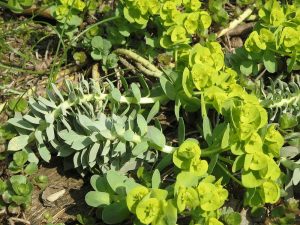
Steppe gophers were used for food, too:
“Later, that wasn’t all, I have no idea how we lived on and how I survived. We – young boys and girls gathered together – used to take buckets full of water and go to the steppe. We looked for holes in the ground, where the susliks (or gophers, – Ed.) lived. And we, the girls, poured water from the bucket, and the boys held their hands like this. With water poured down, the susliks pull their heads out to escape. And the boys grasp them hit them against the ground, and that’s it, we have meat. We’d gather a lot of susliks, divide them among us, go home to have them skinned and eat their meat. It was very good that we had the susliks. And somehow we survived,” Oleksandra says.
Ms. Leontieva goes on,
“What else did my mom do? She used to pluck the horse sorrel. Then there was some bran and no one had taken it away. Horse sorrel and bran. She used them to cook the ‘matorzhenyky’ as they were called. She’d roast them in a pan and we’d eat those ‘matorzhenyky.’ And later, when we had beetroots, she cooked them from beets, very nice and sweet. The beetroots were so sweet, the white beets (fodder beet, – Ed), right. And this is how we lived.”
People ate dogs, dead horses, and even human corpses:
“They say that in the north – Bratske Raion is there – the famine was more severe. And there they even once roasted and ate a baby. Halyna Fedorivna told me that human meat isn’t tasty, isn’t tasty, but people would eat it. And they used to eat dead horses. And in our parts, only dogs were eaten. Yaryna and Klavka killed the dog and ate it. Everyone did their best to survive. We starved badly, I wanted bread, and where was it? None, there is no bread, if we only have one single slice, nowhere, no bread anywhere. And from what would you bake it? There was no flour, and they had taken even beans from people,” Oleksandra recalls.
Starving people from other villages begged for food
Meanwhile, the famine was ravaging Ukraine. Thousands of people migrated searching for food in other villages and cities, but they were rarely lucky to find anything.
“What I remembered is that people swollen from starvation appeared in our village. And I took notice of their legs. They had such thick, swollen legs. And these people, these hungry (and we were hungry, too), these people, men and women, used to walk around the village and begged for whatever someone had. At the same time, they sneaked into people’s cellars both day and night. They thought, ‘Maybe, we’ll find something to eat there.’ They were hungry. All of us were hungry, we didn’t see the bread.”

In Oleksandra’s village, even communist activists starved, half her village died
“Then I hear people talk, ‘Maksym has already died there, Nyken died, Zakhar died, Savka died.’ I heard them telling who died of our villagers. Everyone was starving. I know, everyone was starving, even the activists. And their children were starving, too. We used to catch susliks together with them. And that boy says that they have nothing and he is hungry. Everyone wanted to eat,” Oleksandra said.
Nevertheless, Oleksandra’s fellow villagers tried to help each other as much as they could. Oleksandra Leontieva recalled such an example,
“Once someone came to us at night, our house was open, we didn’t lock up our door. It was Maksym. I remember my mom saying ‘Is this you, Maksym?’ He often used to come to us, come to us. We gave him whatever we had, like those fried turtles. And then he once came to us at night, I remembered that, and my mom said, ‘Is this you, Maksym?’ ‘It’s me, Maksym.’ ‘Why did you come? We have nothing, Maksym, go away. Go away,’ my mom said, ‘Go away from our house, because there is nothing here.’ And this Maksym died, too. All these people are from our village, Maksym, Savka, Zakhar, Klavka, the one who killed the dog with Yaryna.”

- Read also: My village once saw twelve people die of hunger in one day | Voices of Holodomor witnesses
There was no horse cart in the village to gather the dead, so those alive would carry the dead on their shoulders. No headstones were put on the graves back then, and later for a few decades, the Holodomor genocide had been denied and concealed by the communist totalitarian regime. This old cemetery and the Holodomor victims’ graves remained abandoned, over time it became overgrown with grass and now it is impossible to establish the exact spots of mass graves there.
“Later, we didn’t mention the famine,” Ms. Leontieva says. “No one. As if everyone forgot it. No one talked then. No one.”
The famine of 1946-1947 also hit Oleksandra’s village, but not as hard as the Holodomor
Oleksandra Leontieva also survived the mass artificial famine of 1946-1947, but the situation in the village was not as horrible as it was in 1932-1933:
“Bread was rationed, then there was a famine. I remember when I was receiving a loaf of bread with my food stamps, I’d eat almost all the loaf at once. It was also a famine, but not like that, not like I saw.”
“They wanted us all dead”
Of course, Oleksandra Leontieva wondered many times in her life why the Holodomor befell her, her family and their village. The answer she found for herself fully confirms the genocidal nature of that terrible famine,
For what other conclusion can be drawn? They wanted to starve us so that we’d be gone. That’s just the way it is. That’s what we all thought, not just me, but everyone thought so. And we, thank God, you see what we used to eat, I tell you, we ate grass, and ate gophers, and ate dogs. Everything. How? When a human wants to eat, then what?”
Further reading:
- My neighbor buried her three children | Voices of Holodomor witnesses
- Every day two or three people died in our village | Voices of Holodomor witnesses
- My village once saw twelve people die of hunger in one day | Voices of Holodomor witnesses
- My family survived Holodomor by eating waste left from sugar production | Voices of witnesses
- Surviving in the “collective farm paradise”: voices of living Holodomor witnesses
- How my father saved his co-villagers from starvation during the Holodomor
- My neighbors escaped starvation by eating grain stored by field mice | Voices of Holodomor witnesses
- “Let me take the wife too, when I reach the cemetery she will be dead.” Stories of Holodomor survivors
- Stalin’s management of Red Army proves Holodomor a Soviet genocide against Ukrainians
- Holodomor in Kharkiv through the lens of Austrian engineer: photo gallery
- Holodomor: Stalin’s punishment for 5,000 peasant revolts




